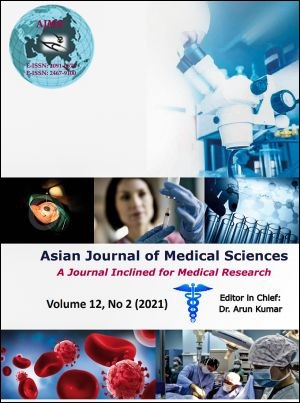Clinical profile of patients undergoing abdominal hysterectomy at a medical college in Nepal
Keywords:
Abdominal hysterectomy, Fibroid, parity, pain abdomen, menstrual symptoms, blood lossAbstract
Background: Hysterectomy, removal of the uterus, is one of the most frequently performed gynecological surgeries, with approximately six hundred thousand women undergoing this procedure annually in the United States. Indications of hysterectomy vary from benign conditions to malignancies of the genital tract. Hysterectomy is also associated with intraoperative and postoperative complications.
Aims and Objectives: The aim of the current study was to analyze indications, complications, duration of hospital stay, blood loss during surgery and correlation of preoperative diagnosis with final histopathology report of all abdominal hysterectomies performed at a teaching hospital.
Materials and Methods: This study involved all patients who underwent abdominal hysterectomy at Manipal Teaching Hospital, Pokhara, Nepal over a span of 18 months (from 1st January, 2018 to 31st June, 2019). It was a retrospective study. All the patients undergoing abdominal hysterectomy during the study period were taken without any exclusion criteria.
Results: There were 101 cases of abdominal hysterectomies performed during the study period. Majority of the patients were from urban areas than rural areas (67.3% vs 32.7%). Mean age of patients undergoing abdominal hysterectomy was 45.48 years with 2 standard deviation (SD) of 8.75. The youngest patient aged 26 years and the eldest aged 67 years. Mean parity was 2.50 with 2 SD of 1.197. Majority of the patients presented with pain abdomen (49.5%) and menstrual disorders (38.6%). The most common indication for hysterectomy was uterine fibroids (51.5%) followed by ovarian pathology (16.8%). The histopathology report of the patients showed that majority of the patients had fibroid uterus (51.4%) and ovarian pathology (16.8%). Mean intraoperative blood loss was 239.60 ml with 2 SD of 197.144. Mean hospital stay was: 7.29 days with 2SD of 3.144. The maximum hospital stay was 18 days in two patients and most patients had hospital stay between 5 to 8 days. The commonest complication was surgical site infection (9.9%) needing resuturing followed by urinary tract infection (7.9%).
Conclusion: Wide spectrums of lesions were encountered during the surgery. The preoperative diagnosis, duration of hospital stay, average blood loss, surgical complications and histopathological reports correlated with various others studies.
Downloads
Downloads
Published
How to Cite
Issue
Section
License
Authors who publish with this journal agree to the following terms:
- The journal holds copyright and publishes the work under a Creative Commons CC-BY-NC license that permits use, distribution and reprduction in any medium, provided the original work is properly cited and is not used for commercial purposes. The journal should be recognised as the original publisher of this work.
- Authors are able to enter into separate, additional contractual arrangements for the non-exclusive distribution of the journal's published version of the work (e.g., post it to an institutional repository or publish it in a book), with an acknowledgement of its initial publication in this journal.
- Authors are permitted and encouraged to post their work online (e.g., in institutional repositories or on their website) prior to and during the submission process, as it can lead to productive exchanges, as well as earlier and greater citation of published work (See The Effect of Open Access).




